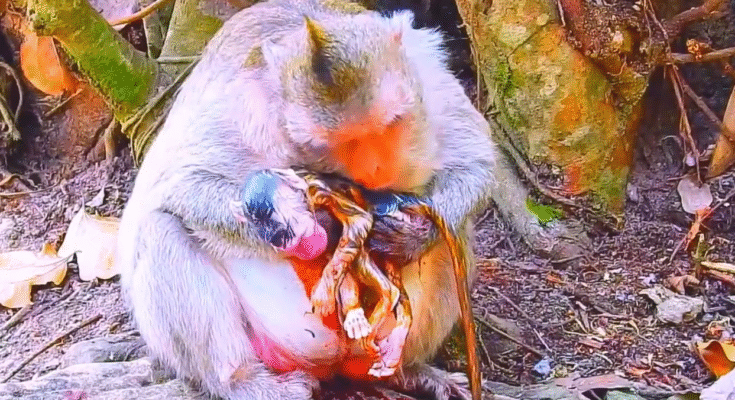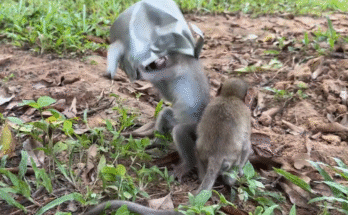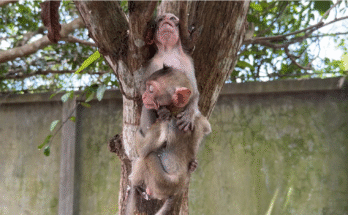Introduction: A Scene in the Forest
Deep in the emerald canopy of a tropical forest, sunlight filters through tall leaves and dances on the forest floor. In the heart of this lush world, a small troop of monkeys gathers near a stream. Their chatter fills the air like music — high-pitched, rhythmic, and alive. But today, something unusual is happening. Among them sits an older monkey, thin and frail, its fur patchy, eyes weary. The troop has discovered that one of their own is hungry and weak. What unfolds next is a simple yet powerful act of kindness: monkeys feeding a hungry companion with carrots, beans, and radishes.
This is not just a scene of survival — it is a reflection of empathy, cooperation, and intelligence in the animal kingdom.
The Social Bonds of Monkeys
Monkeys are highly social creatures. They live in troops ranging from a few individuals to hundreds, depending on the species. Social structure plays a vital role in their survival — it dictates who leads, who follows, who eats first, and who cares for whom. Within these groups, food sharing is not merely practical; it is emotional.
Primatologists have long observed that monkeys demonstrate empathy — a quality once thought to be uniquely human. When one member is injured, others groom or sit beside it. When a juvenile loses its mother, older females sometimes adopt it. Sharing food, especially with the sick or weak, is a profound gesture that shows a deep understanding of the group’s unity.
A Story of Sharing
On one warm morning, a group of macaques found an elderly monkey struggling to forage. Its movements were slow, its energy nearly gone. Instead of ignoring it, the younger members began bringing food. One monkey pulled up a radish from a nearby garden patch — crisp, white, and earthy. Another scavenged a handful of green beans that had fallen from a farmer’s basket. A third returned with pieces of orange carrot, bright as the morning sun.
The younger monkeys placed these offerings before the elder, chirping softly as if urging it to eat. The hungry monkey reached out, trembling, and began to chew slowly. Around it, the troop watched — quiet, alert, and respectful. The moment felt sacred in its simplicity.
To an observer, it might seem like mere instinct. But to those who study animal behavior, such acts reveal something more profound: the capacity for empathy and social care among non-human primates.
Nutritional Wisdom: Nature’s Balance
Interestingly, the foods in this story — carrot, beans, and radish — provide a nutritional balance that monkeys instinctively understand.
-
Carrots are rich in beta-carotene and natural sugars, offering energy and eye health support.
-
Beans provide plant protein and fiber, aiding digestion and muscle recovery.
-
Radishes help hydration and contain essential minerals like calcium and potassium.

Monkeys do not read nutrition labels, but evolution has taught them to recognize what their bodies need. They often select foods based on color, texture, and taste — signs of ripeness and nutrient content. When one monkey shares such foods, it’s not only offering nourishment but also instinctively maintaining the group’s well-being.
Empathy Beyond Survival
Many people underestimate the emotional intelligence of animals. Yet studies across species — from dolphins to elephants to primates — show that empathy, mourning, and altruism exist in the wild. In this case, feeding the hungry monkey isn’t just about food; it’s about connection.
Young monkeys learn by watching their elders. When they see compassion expressed through sharing, they internalize that behavior. This cycle of empathy strengthens the troop’s unity and ensures survival through cooperation rather than competition.
As one researcher noted, “A troop that shares food shares strength.”
Human Parallels: Lessons from the Wild
Humans often see themselves as separate from animals, but scenes like these remind us of our shared ancestry. The act of feeding someone hungry — whether in the forest or in a city street — is one of the oldest gestures of kindness in existence.
Watching monkeys feed one another can stir something deeply human in us: the recognition that kindness is not a human invention. It is a universal force of nature.
In a world often marked by conflict and scarcity, the quiet image of monkeys sharing carrots and beans with their weak companion offers a message of unity. It tells us that compassion can exist even where survival is the only law.
Monkeys and Farmers: Coexistence at the Edge
Interestingly, many of these foods — carrots, beans, and radishes — are human-grown. In regions where forests meet farmland, monkeys often forage in cultivated areas. While this sometimes leads to conflict with farmers, it also creates fascinating moments of coexistence.
Farmers in parts of South and Southeast Asia have observed monkeys carefully picking vegetables without damaging the plants. Some compassionate farmers even leave a small portion of crops near the edge of the fields — offerings for the forest dwellers who share their land.
It’s a delicate balance — one that reflects the interconnectedness between humans and wildlife.
Scientific Insights: Food Sharing Among Primates
In scientific research, food-sharing behavior has been documented among many primate species:
-
Chimpanzees often share meat after a hunt, especially with those who helped or with mothers and infants.
-
Bonobos share fruit as a form of bonding and even reconciliation after conflicts.
-
Capuchin monkeys have been seen passing fruit pieces to injured members of their group.
-
Macaques, like those in our story, demonstrate “reciprocal altruism,” helping others with the expectation that the kindness will one day be returned.
This indicates a form of moral intelligence — the ability to sense fairness and kindness.
When a monkey feeds another, it’s not acting blindly; it’s engaging in a complex social ritual of empathy, gratitude, and future trust.
Conservation Message: Protecting the Gentle Ones
Unfortunately, the forests that nurture these social miracles are shrinking. Habitat loss, deforestation, and human encroachment threaten the lives of monkeys worldwide. When trees fall, so do the bridges of community that connect them. Hungry monkeys often wander into human settlements — not out of mischief, but necessity.
By protecting their habitats, we protect not just the species but also the lessons they teach — compassion, sharing, and respect for life.
Simple actions such as planting fruit trees along forest edges, supporting wildlife sanctuaries, or reducing the use of harmful chemicals can make a world of difference.
After all, the kindness that monkeys show each other mirrors the kindness we must show to them.
A Quiet Lesson in the Canopy
As the day fades in our story, the elderly monkey rests beneath a banyan tree, its belly full and its spirit calmer. The younger ones continue to play, leaping from branch to branch, occasionally glancing back at their friend. The forest hums with life — birds call, insects buzz, leaves rustle in the wind.
This moment — a troop feeding its weakest member — may last only a few minutes, but its meaning endures. It is a whisper from nature: Even in the wild, kindness thrives.
Conclusion: The Universal Language of Compassion
The act of monkeys feeding carrots, beans, and radishes to a hungry companion is not just a charming anecdote — it is a profound symbol. It reveals that empathy transcends species, language, and environment. It reminds us that intelligence is not measured solely by tools or words, but by the capacity to care.
In every forest, there are stories of survival. But there are also stories of love — quiet, unrecorded, and powerful.
This is one of them: a story of monkeys, vegetables, and the unbreakable thread of compassion that binds all living things together.



